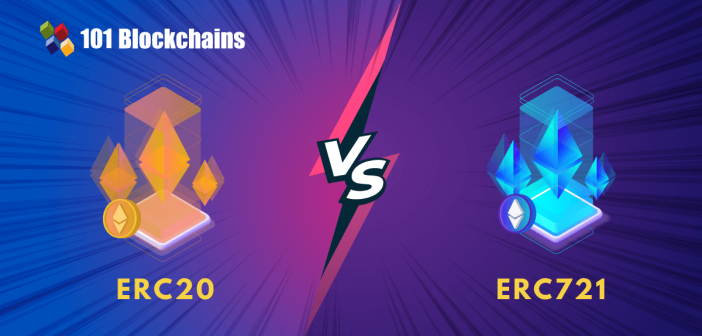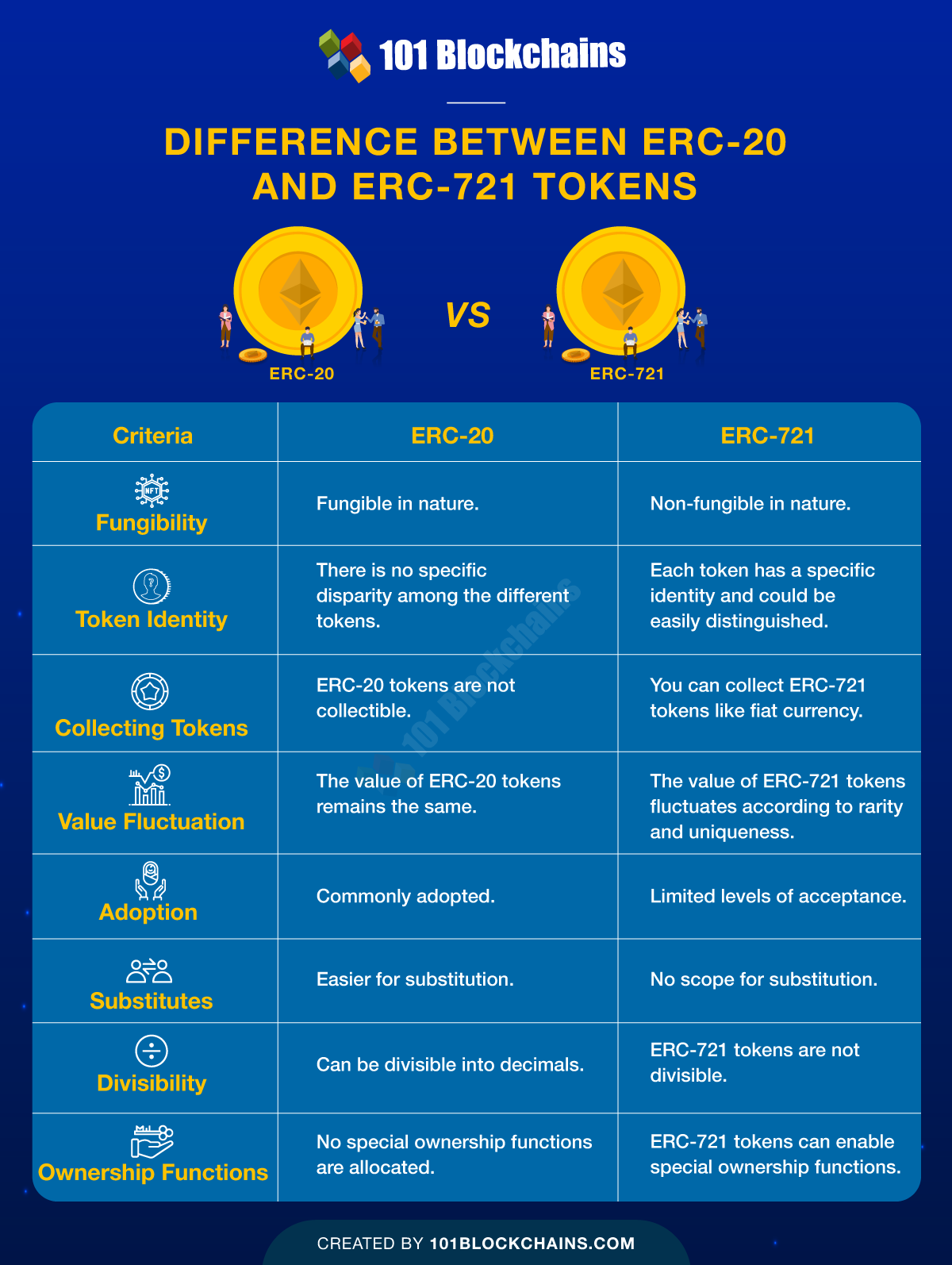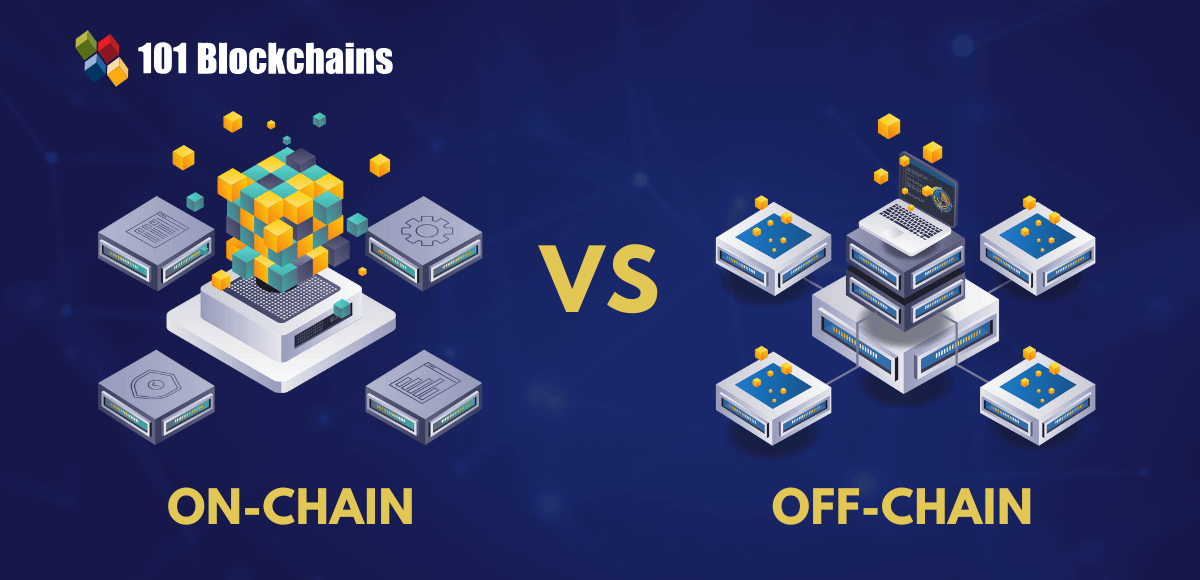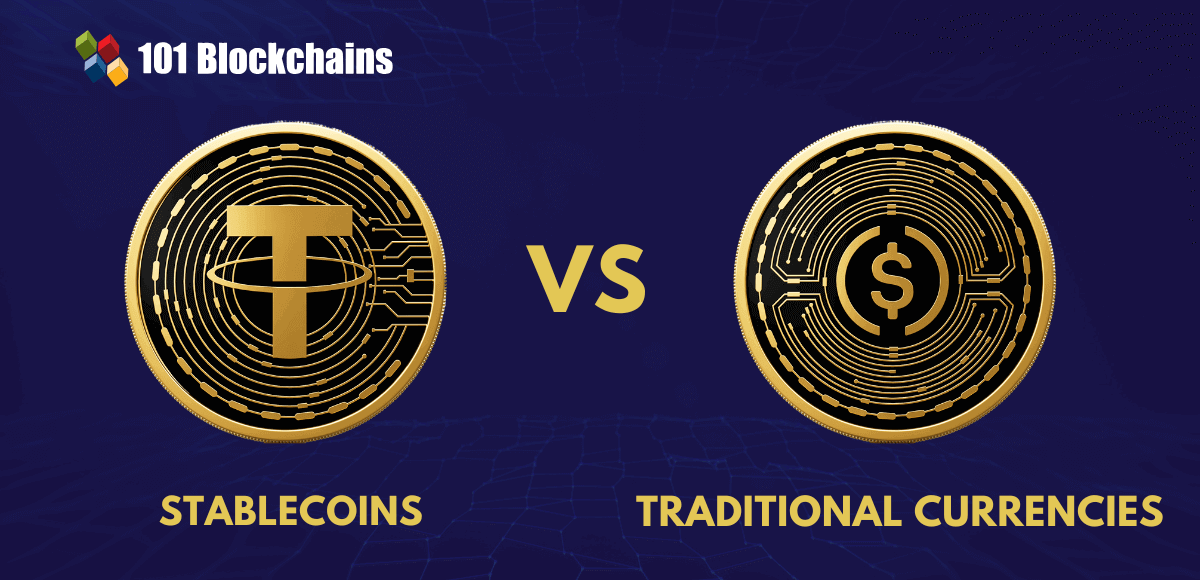Learn how blockchain truly works, master key definitions, and uncover what makes smart contracts so "smart." Dive into the fundamentals, gain valuable insights, and start your blockchain journey today!

- Comparisons
Gwyneth Iredale
- on November 19, 2021
ERC20 vs. ERC721 – Key Differences
Ethereum is a big name in the world of blockchain for obvious reasons. It is the second-largest blockchain platform which serves as the first choice for developing blockchain-based decentralized applications. The arrival of Ethereum in 2015 introduced completely new possibilities for decentralization with the opportunities for the development of decentralized applications and the use of smart contracts. Subsequently, Ethereum tokens started gaining popularity in 2016 and 2017, thereby giving rise to the ERC20 vs. ERC721 comparison debates.
The tokens caught the attention of ICOs as suitable instruments for representing ownership or utility. Subsequently, Ethereum tokens also discovered promising uses as representatives for in-game assets such as in the popular NFT game CryptoKitties. The different highlights of the tokens in the ERC721 vs. ERC20 debate draw attention towards them. The following discussion offers a detailed overview of both the ERC20 and ERC-721 tokens alongside a reflection on the differences between them.
Excited to learn the basic and advanced concepts of ethereum technology? Enroll Now in The Complete Ethereum Technology Course
What is ERC?
The first thing you need to understand the ERC20 vs. ERC721 differences is a clear impression of ERC tokens in general. ERC basically means Ethereum Request for Comments, and its basic role is offering functionality for Ethereum. It features a standard set of rules for creating tokens on Ethereum. The instructions in the ERC tokens outline the sales, purchases, unit limits, and existence of tokens.
The rules specified with each token standard could help exchanges, applications, and wallets in understanding the basic monetary functions. Generally, developers are responsible for generating the token standards, which also provide contract descriptions and protocol specifications. On the most basic level, ERC is just public and open system that allows any individual to create and provide comments on the proposals for the standardization of Ethereum tokens and smart contracts.
ERC-20 and ERC721 tokens are the initial types of ERC token standards that serve an important role in defining the functionality of the Ethereum ecosystem. You can think of them as the standards for the creation and publication of smart contracts on the Ethereum blockchain. It is also important to note that people could invest in tokenized assets or smart properties created with the help of smart contracts. ERC is more of a template or format which all developers should follow in developing smart contracts. The best thing about ERC is that it could help in easier code writing with improved predictability and prospects for reusing the code.
Want to learn the basic and advanced concepts of Ethereum? Enroll in our Ethereum Development Fundamentals Course right away!
Understanding Fungibility and Non-fungibility
If you want to understand the ERC20 vs. ERC721 differences clearly, then you need to know the differences between fungibility and non-fungibility. Fungible assets are the assets that you can swap with another similar entity. For example, you can swap currency or shares with similar values. You can exchange a one-dollar bill with any other one-dollar bill as all of them represent same value.
On the other hand, non-fungible assets are the opposite and cannot be swapped for one another. For example, a house could be easily considered a non-fungible asset as it would have some unique properties. When it comes to the crypto world, representation of assets in the digital form would definitely have to consider the aspects of fungibility and non-fungibility. How is the concept of fungible and non-fungible assets relevant in a discussion about ERC20 and ERC-721 tokens? A comprehensive overview of the two distinct ERC token standards could help in understanding the ERC721 vs. ERC20 difference clearly.
Also Read: Detailed comparison between ERC20 vs ERC 223 vs ERC777.
ERC-20 Tokens
The first thing that you would need for understanding the differences between ERC20 and ERC-721 tokens would refer to the definition of the tokens. With the growing popularity of smart contracts, users preferred the creation of contracts that served as tokens. As the use of smart contracts in such a manner started to gain prominence, it was difficult to maintain records of coding tokens by leveraging Ethereum smart contracts. The early Ethereum smart contract tokens did not feature similar sets of information in the same formats. As a result, token ecosystems started to experience formidable difficulties in interacting and establishing synergy with each other.
As a result, the ERC20 tokens came into existence with the efforts of Fabian Vogelsteller in 2015. The ERC-20 token standard supported the implementation of a standard API or Application Programming Interface for tokens in smart contracts. So, ERC20 serves as a standard protocol for the Ethereum blockchain and enables users to share, exchanging or transfer tokens. The standardization with ERC-20 presented prolific opportunities for programmers to achieve token designs in accordance with a specific set of rules.
Therefore, the ERC-20 token standard is easier to use throughout the Ethereum blockchain. The standard content in ERC-20 token would include distinct components such as Token Name, Symbol, Decimal, totalSupply, balanceOf, transfer, transferFrom, Allowance, and approve. The first three components, i.e., Symbol, Decimal, and Token name, are optional entities in ERC20 tokens. However, the other six components are mandatory for the tokens following ERC-20 standard.
Curious to understand the complete smart contract development lifecycle? Join the Standard & Premium Plans and get free access to the Smart Contracts Development Course Now!
Functions of Components in ERC-20 Tokens
If you want to understand ERC721 vs. ERC20 differences clearly, then you need to know the work of distinct components in ERC-20 tokens. The components in ERC-20 tokens have specific uses which can help in understanding them better.
- The “Token Name” component specifies the name of the token to users.
- With the “Symbol” component, users could find the ticker symbol for the token.
- The “Decimal” component in the ERC20 token specifies the divisibility of the token.
- totalSupply is an important mandatory component of ERC-20 tokens as it showcases the total supply of the token.
- The “balanceOf” component provides information about the account balance in the owner’s account.
- “transfer” component in the token focuses on enabling the transfer of a specific number of tokens to a user account from the total supply.
- The “transferFrom” component helps in transferring tokens between users.
- With the “approve” component, the tokens can allow spenders to withdraw a particular number of tokens from a given account.
- “allowance” specifies the set number of tokens that are returned from the spender to the owner.
ERC-721 Tokens
ERC721 tokens have become quite popular in recent times with the radically growing attention towards NFTs. As a matter of fact, the basic nature of ERC-721 tokens is one of the formidable factors for ERC20 vs. ERC721 differences. ERC-721 tokens are also referred to as NFTs. Developed by Nastassia Sachs, William Entriken, and Dieter Shirley, ERC-721 token standards help developers in tokenizing the ownership of any type of arbitrary data. As a result, the ERC721 token standard basically changed the conventional perceptions regarding the representation of assets on the blockchain.
The working of ERC-721 tokens also influences the discussions on ERC721 vs. ERC20 comparisons. Interestingly, the ERC-721 token standard also follows a specific collection of standards just like the ERC-20 tokens. The standards in ERC-721 tokens focus on critical aspects for deciding ownership and approaches for the creation of tokens. The standards also dictate the approaches for destroying and transferring the tokens.
Components of ERC-721 Tokens
From a technical perspective, the ERC20 vs. ERC721 difference becomes clear with an understanding of their components. It is important to note that ERC-721 is more of an Ethereum Improvement Proposal or EIP. ERC-721 is basically a proposed standard that can help smart contracts for working as tradable tokens just like ERC-20 tokens. ERC721 tokens have the value of uniqueness in the fact that they are non-fungible in nature.
Another important factor about ERC-721 tokens refers to the flexibility for using them in almost any exchange. However, the value of ERC-721 tokens depends considerably on the uniqueness and rarity associated with each token. The ERC721 standard provides a definition for important components such as Functions name, Symbol, totalSupply, balanceOf, ownerOf, approve, transfer, takeOwnership, tokenMetadata and tokenOfOwnerByIndex.
ERC-721 tokens provide better prospects for defining the events of transfer and approval. The introduction of the new ERC721 standard has opened up new possibilities for smart contracts to serve as non-fungible assets. You can notice ERC-721 tokens in notable applications such as CryptoPunks, CryptoKitties, and many others.
Start learning about second-most-popular blockchain network, Ethereum with World’s first Ethereum Skill Path with quality resources tailored by industry experts Now!
Difference between ERC-20 and ERC-721 Tokens
The basic difference you find in ERC20 vs. ERC721 comparisons would directly point to the fungibility of ERC-20 tokens. On the other hand, ERC-721 tokens are non-fungible. While ERC-20 tokens represent a single asset and are interchangeable, ERC-721 tokens are indivisible and represent a collection of assets.
Here is a detailed overview of the differences between ERC-721 and ERC-20 tokens –

Please include attribution to 101blockchains.com with this graphic. <a href='https://101blockchains.com/blockchain-infographics/'> <img src='https://101blockchains.com/wp-content/uploads/2021/11/Difference-between-ERC-20-and-ERC-721-Tokens.png' alt='Difference between ERC-20 and ERC-721 Tokens='0' /> </a>
Bottom Line
The ERC20 and ERC-721 tokens are the foundations of the thriving Ethereum ecosystem. They provide the foundation for defining smart contracts, which are the core elements in modern blockchain-based decentralized applications. The understanding of ERC721 vs. ERC20 differences is essential for developers to figure out the ideal token standards.
With the specific approaches for representing asset ownership and flexibility of access, the two token standards have some formidable disparities. With the growing demand for NFTs, ERC-721 tokens are definitely a hot topic now. However, the basic functionalities of ERC-20 tokens cannot be left out of the equation in any case. Learn more about ERC tokens and find out the suitable option for your use cases.
If you want to know more about blockchain, enroll for blockchain courses and certifications!
*Disclaimer: The article should not be taken as, and is not intended to provide any investment advice. Claims made in this article do not constitute investment advice and should not be taken as such. 101 Blockchains shall not be responsible for any loss sustained by any person who relies on this article. Do your own research!






